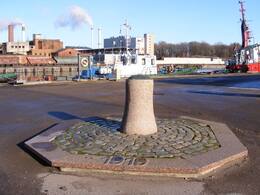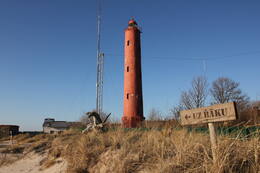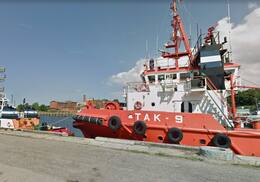Artūro Ozolo prisiminimai apie laivą „Saratov“
Artūras Ozolas baigė Rygos politechnikos institutą ir tarnavo Rusijos Juodosios jūros laivyne karininku (mičmanu) ir inžinieriumi karo laive „Panteleimon“. Latvijos išsivadavimo kovos metu jis įstojo į Studentų kuopą. Liepojoje jis pradėjo eksploatuoti laivą „Saratov“. Artūro Ozolo atsiminimai apie laivą „Saratov“ buvo publikuoti Daugagavos Vanagi mėnesiniame leidinyje.
„Vyriausybė pripažino plaukiojančios transporto priemonės poreikį, kad vyriausybė galėtų turėti laivą, su kuriuo galėtų operuoti, galbūt perkelti karius į Ventspilį. Strateginiu požiūriu kariuomenė tai laikė būtinu, taip pat ir moraliniu požiūriu, kad tuo atveju, jei viskas sugriūtų ir mūsų jauna armija – neginkluota, neapmokyta, traukiantis iš Rygos į Jelgavą, iš Jelgavos per Kuržemę Liepojos kryptimi – bent žinotų, kad mumis pasirūpinta. Blogiausiu atveju mes įliptume į laivą ir mums būtų užtikrinta galimybė atsitraukti. Kaip vėliau man pasakojo mano brolis Markusas, kuris buvo fronte, šis suvokimas suteikė kovotojams fronte naujos energijos. Taigi jie turėjo ieškoti laivo, bet kai apsidairė, jo nebuvo. Buvo tik vienas – ant šono pasviręs „Saratov“. Kadangi pats esu jūreivis, norėjau susiorientuoti savo specialybėje ir nuvykau į „Saratovą“ pažiūrėti, kas ten iš tikrųjų yra. Laive, kurį sutikau, buvo tik kūrikas, mašinų skyrius buvo pilnas vandens,“ tik vienas katilas su žemu slėgiu. Paklausiau, kodėl vanduo iš mašinų skyriaus nėra išpumpuojamas.
„Tai ne mano reikalas, nenoriu nieko teigiamo padaryti vokiečiams.“
„Mums, latviams, reikia laivo.“
„A, tai jau kitas reikalas.“
„Saratovas“ buvo vienintelis laivas, galėjęs būti Laikinosios vyriausybės žinioje, tačiau jį reikia gauti iš to, kam jis priklauso. Pasirodo, jis priklauso Rusijos Vakarų laivybos bendrovei, plaukioja su Rusijos vėliava, kapitonas – Remessas, latvis, kuris ten buvo visą laiką. Kaip galime jį gauti savo žinioje, kur aplinkui tvyro vokiečių valdžia, o mes neturime jokios įtakos?
Nuvykau pas Zālītį ir pasakiau, kad galime mobilizuotis ir užimti Saratovą. Taip laivas pateko į Laikinosios vyriausybės rankas. Kodėl vokiečiai neprotestavo, nežinau. Man atrodo, kad po kelių savaičių šis veiksmas nebūtų buvęs sėkmingas. Vokiečiai jau buvo susiorganizavę prieš Laikinąją vyriausybę ir nebūtų jiems leidę to daryti. Dabar reikėjo sutvarkyti laivą ir pradėti jį remontuoti. Susidūriau su sunkumais: be žmogaus, kuris jau buvo laive, negalėjau nieko atvykti ir padėti man dirbti. Darbininkai buvo prieš Laikinąją vyriausybę, nes jiems teko kovoti ne tik prieš vokiečius, bet ir prieš Latvijos darbininkus. Ilgą laiką negavau jokios pagalbos, kol neatvyko kaimynas. Mudu dviese sutvarkėme laivą, bet darbo buvo daug. Tada buvau iškviestas į štabą.
„Pone Ozolai, rytoj ryte turite išplaukti į jūrą.“
"Bet aš turiu tik vieną puodą."
„Pasiruoškite, kad galėtumėte išplaukti į jūrą. Ten yra anglų eskadrilė, iš kurios pasiimsite daugiau nei 5000 šautuvų, šimtus tūkstančių sviedinių, 50 savaeigių pabūklų. Anglai nenori čia įžengti, kad nesukeltų konflikto su vokiečiais; Jurmas turi ten vykti.“
Sausio pabaigoje lėtai judėjome su vienu katilu, bet išsikapstėme labai gerai. Sustojome prie vieno iš anglų karo laivų ir tamsoje prasidėjo perkrovimas. Taip pat gavome dalykų, kurių Liepojoje seniai nebuvo matyti. Anglai buvo labai malonūs, daug broliavomės. Turėjau žinoti apie katilą ir tuo pačiu metu pabūti vertėju, nes nebuvo nė vieno, kuris mokėtų angliškai ir galėtų vaikinams pasakyti, kad instruktorius moko elgtis su naujais automatais, kurių mūsų vaikinai net nebuvo matę. Kai viskas buvo sutvarkyta, su vienu katilu ir brangia kulka grįžome į Liepoją. Šautuvai turėjo būti surinkti šaudymo tvarka, reikėjo samdyti žmones, bet pinigų nebuvo. Juos taip pat reikėjo pristatyti į frontą, kur jų reikėjo. Reikėjo rasti darbininkų, kurie nepakenktų mūsų reikalams. Tokia buvo aplinka Liepojoje tuo metu.“
Kas buvo Artūras Ozolas?
Artūras Ozolas baigė Rygos politechnikos mokyklą ir tarnavo Rusijos Juodosios jūros laivyne karininku (mičmanu) ir inžinieriumi karo laive „Panteleimon“. Latvijos išlaisvinimo mūšiuose jis dalyvavo Studentų kuopoje. Liepojoje jis paruošė laivą „Saratov“ eksploatuoti.
Jis buvo išrinktas į Steigiamąjį susirinkimą, vėliau Edinburge, Škotijoje, kaip ekspertas prižiūrėjo pirmojo mūsų ledlaužio „Krišjānis Valdemārs“ statybą. Daugelį metų buvo Jūrų departamento direktorius. Po Antrojo pasaulinio karo buvo pirmasis tremtyje veikiančio Skandinavijos nacionalinio fondo valdybos pirmininkas. Mirė Švedijoje.
Artūro Ozolo prisiminimai apie laivą „Saratov“ (Daugavo Vanagu mėnesinis žurnalas Nr. 6, 1980 m. lapkričio 1 d.).
Susijusi laiko juosta
Susijusios temos
Susijusios vietos
Laivo „Saratov“ prieplauka Liepojoje
„Saratov“ prieplauka yra Liepojoje, Senojoje uoste, 59, netoli laivų prieplaukos.
Pastatytas 1888 m. Kopenhagoje laivų statyklos „Buvmeistar & Wain“ pavadinimu „Leopold II“, 1911 m. jį įsigijo akcinė bendrovė „Russian North-West Shipping“ ir pervadino į „Saratov“, o laivo kapitonu tapo latvis Aleksandras Remessas.
1915 m. gegužę, kai Liepoją okupavo vokiečių kariuomenė, laivas „Saratovas“ uoste buvo apgadintas.
1919 m. sausio 10 d. garlaivį „Saratov“ perėmė Latvijos laikinoji vyriausybė. Nuo 1919 m. balandžio iki liepos mėn., po „balandžio 16 d. perversmo“, K. Ulmanio vadovaujama laikinoji vyriausybė buvo „Saratov“ laive ir buvo priversta slėptis sąjungininkų laivyno globoje.
1919 m. liepos 8 d., laikinajai K. Ulmanio vyriausybei perdavus Rygą, garlaiviai buvo naudojami susisiekimui tarp Rygos, Ventspilio ir Liepojos.
Pagal 1920 m. rugpjūčio 11 d. Latvijos ir Sovietų Rusijos taikos sutarties sąlygas garlaivis „Saratovas“ turėjo būti grąžintas Sovietų pusei. 1923 m. sausio 2 d. garlaivis buvo perduotas Sovietų Rusijos atstovui. 1923 m. sausio 15 d. garlaivis „Saratovas“ sudužo prie Akmenrago krantų.
1936 m. Latvijos jūrų departamentas pardavė nuolaužas įmonei, kuri jas sutvarkė ir perdavė Liepojos audinių fabrikui.
Akmeņrago švyturys ir „Saratovo“ likimas
Akmeņrago švyturys yra Sakos valsčiuje, 10 kilometrų į pietvakarius nuo Paviluostos. Į švyturio viršūnę galima patekti spiraliniais laiptais, iš jos atsiveria vaizdas į jūrą ir aplinkinius miškus. Dabartinis 37 metrų aukščio švyturio bokštas buvo pastatytas 1921 m., o ankstesnis švyturys buvo sunaikintas per Pirmąjį pasaulinį karą.
Akmeņrago švyturys išsiskiria iš kitų Latvijos švyturių, nes yra vienoje pavojingiausių laivybai vietų visoje Baltijos jūros pakrantėje. Švyturio signalinis spindulys žymi uolėtą krantą, kuris šiaurės vakarų kryptimi tęsiasi maždaug dvi jūrmyles arba 3,7 kilometro į jūrą. Kranto gylis yra kiek daugiau nei du metrai. Švyturio vieta nepakito, tačiau pakrantė bėgant metams tolsta. Nors navigacijos šviesa čia yra nuo 1879 m., Akmeņrage įvyko keletas laivų avarijų. Žymiausia įvyko 1923 m. rugsėjį, kai į seklumą atsitrenkė Latvijos garlaivis „Saratow“. 1919 m. Saratovas trumpai buvo Latvijos laikinosios vyriausybės būstinė. Akmeņrage anksčiau buvo pasienio apsaugos postas, čia galima apžiūrėti sovietų armijos pastatus.
Tikroji laivo „Saratov“ švartavimosi vieta
Tikroji laivo „Saratov“ prieplauka yra Liepojoje, Vecā ostmalā 59, netoli laivų prieplaukų, tačiau memorialas yra visai šalia Liepojos specialiosios ekonominės zonos.
Pastatytas 1888 m. Kopenhagoje, laivų statykloje „Buvmeistar & Wain“, pavadinimu „Leopold II“. 1911 m. jį įsigijo Rusijos šiaurės vakarų laivybos kompanija ir pervadino į „Saratov“, o laivo kapitonu tapo latvis Aleksandras Remessas.
1915 m. gegužę, kai Liepoją okupavo vokiečių kariuomenė, laivas „Saratov“ buvo uoste apgadintas.
1919 m. sausio 10 d. garlaivis „Saratov“ buvo perimtas Latvijos laikinosios vyriausybės reikmėms. Nuo 1919 m. balandžio iki 1919 m. liepos mėn. K. Ulmanio vadovaujama laikinoji vyriausybė po „Balandžio 16-osios perversmo“ buvo laive „Saratov“, kuris buvo priverstas ieškoti prieglobsčio sąjungininkų laivyno globoje.
1919 m. liepos 8 d., atvedus į Rygą K. Ulmanio laikinąją vyriausybę, garlaivis buvo naudojamas eismui tarp Rygos, Ventspilio ir Liepojos.
Pagal 1920 m. rugpjūčio 11 d. Latvijos ir Sovietų Rusijos taikos sutarties sąlygas garlaivis „Saratov“ turėjo būti grąžintas sovietų pusei. 1923 m. sausio 2 d. garlaivis buvo perduotas Sovietų Rusijos atstovui. 1923 m. sausio 15 d. garlaivis „Saratov“ žuvo netoli Akmeņrago.
1936 m. Latvijos jūrų departamentas pardavė laivo nuolaužas įmonei, kuri jas iškėlė ir perdavė metalo laužui Liepojos vielos gamyklai.








